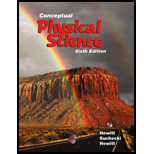
Concept explainers
What is the source of all waves?
Explanation of Solution
Waves are oscillations that can transfer energy.
Waves are disturbance voyages from one location. The disturbance is carried through a medium. It is the transfer of energy trough a medium which is a result of oscillatory motion or regular vibrations that causes simultaneous disturbances.
Waves are results from vibrations. Waves can be categorized based on the direction of propagation. Those waves are perpendicular to the source vibration plane are transverse waves. The waves that are parallel are the longitudinal waves.
Conclusion:
The source of all waves is a vibrating object.
Want to see more full solutions like this?
Chapter 10 Solutions
Conceptual Physical Science (6th Edition)
Additional Science Textbook Solutions
Organic Chemistry (8th Edition)
Microbiology: An Introduction
Microbiology with Diseases by Body System (5th Edition)
Anatomy & Physiology (6th Edition)
Human Anatomy & Physiology (2nd Edition)
Chemistry: An Introduction to General, Organic, and Biological Chemistry (13th Edition)
- The velocity of an elevator is given by the graph shown. Assume the positive direction is upward. Velocity (m/s) 3.0 2.5 2.0 1.5 1.0 0.5 0 0 5.0 10 15 20 25 Time (s) (a) Briefly describe the motion of the elevator. Justify your description with reference to the graph. (b) Assume the elevator starts from an initial position of y = 0 at t=0. Deriving any numerical values you need from the graph: i. Write an equation for the position as a function of time for the elevator from t=0 to t = 3.0 seconds. ii. Write an equation for the position as a function of time for the elevator from t = 3.0 seconds to t = 19 seconds. (c) A student of weight mg gets on the elevator and rides the elevator during the time interval shown in the graph. Consider the force of con- tact, F, between the floor and the student. How Justify your answer with reference to the graph does F compare to mg at the following times? and your equations above. i. = 1.0 s ii. = 10.0 sarrow_forwardStudents are asked to use circular motion to measure the coefficient of static friction between two materials. They have a round turntable with a surface made from one of the materials, for which they can vary the speed of rotation. They also have a small block of mass m made from the sec- ond material. A rough sketch of the apparatus is shown in the figure below. Additionally they have equipment normally found in a physics classroom. Axis m (a) Briefly describe a procedure that would allow you to use this apparatus to calculate the coefficient of static friction, u. (b) Based on your procedure, determine how to analyze the data collected to calculate the coefficient of friction. (c) One group of students collects the following data. r (m) fm (rev/s) 0.050 1.30 0.10 0.88 0.15 0.74 0.20 0.61 0.25 0.58 i. Use the empty spaces in the table as needed to calculate quantities that would allow you to use the slope of a line graph to calculate the coefficient of friction, providing labels with…arrow_forwardPART Aarrow_forward
- answer both questionarrow_forwardOnly part A.) of the questionarrow_forwardIn general it is best to conceptualize vectors as arrows in space, and then to make calculations with them using their components. (You must first specify a coordinate system in order to find the components of each arrow.) This problem gives you some practice with the components. Let vectors A = (1,0, -3), B = (-2, 5, 1), and C = (3,1,1). Calculate the following, and express your answers as ordered triplets of values separated by commas.arrow_forward
- In general it is best to conceptualize vectors as arrows in space, and then to make calculations with them using their components. (You must first specify a coordinate system in order to find the components of each arrow.) This problem gives you some practice with the components. Let vectors A = (1,0, −3), B = (-2, 5, 1), and C = (3,1,1). Calculate the following, and express your answers as ordered triplets of values separated by commas.arrow_forwardOnly Part C.) is necessaryarrow_forwardOnly Part B.) is necessaryarrow_forward
- A (3.60 m) 30.0°- 70.0° x B (2.40 m)arrow_forwardIn general it is best to conceptualize vectors as arrows in space, and then to make calculations with them using their components. (You must first specify a coordinate system in order to find the components of each arrow.) This problem gives you some practice with the components. Let vectors A = (1,0, -3), B = (-2, 5, 1), and C = (3,1,1). Calculate the following, and express your answers as ordered triplets of values separated by commas.arrow_forwardfine the magnitude of the vector product express in sq meters what direction is the vector product in -z or +zarrow_forward
 Glencoe Physics: Principles and Problems, Student...PhysicsISBN:9780078807213Author:Paul W. ZitzewitzPublisher:Glencoe/McGraw-Hill
Glencoe Physics: Principles and Problems, Student...PhysicsISBN:9780078807213Author:Paul W. ZitzewitzPublisher:Glencoe/McGraw-Hill An Introduction to Physical SciencePhysicsISBN:9781305079137Author:James Shipman, Jerry D. Wilson, Charles A. Higgins, Omar TorresPublisher:Cengage Learning
An Introduction to Physical SciencePhysicsISBN:9781305079137Author:James Shipman, Jerry D. Wilson, Charles A. Higgins, Omar TorresPublisher:Cengage Learning University Physics Volume 1PhysicsISBN:9781938168277Author:William Moebs, Samuel J. Ling, Jeff SannyPublisher:OpenStax - Rice University
University Physics Volume 1PhysicsISBN:9781938168277Author:William Moebs, Samuel J. Ling, Jeff SannyPublisher:OpenStax - Rice University Principles of Physics: A Calculus-Based TextPhysicsISBN:9781133104261Author:Raymond A. Serway, John W. JewettPublisher:Cengage Learning
Principles of Physics: A Calculus-Based TextPhysicsISBN:9781133104261Author:Raymond A. Serway, John W. JewettPublisher:Cengage Learning AstronomyPhysicsISBN:9781938168284Author:Andrew Fraknoi; David Morrison; Sidney C. WolffPublisher:OpenStax
AstronomyPhysicsISBN:9781938168284Author:Andrew Fraknoi; David Morrison; Sidney C. WolffPublisher:OpenStax





